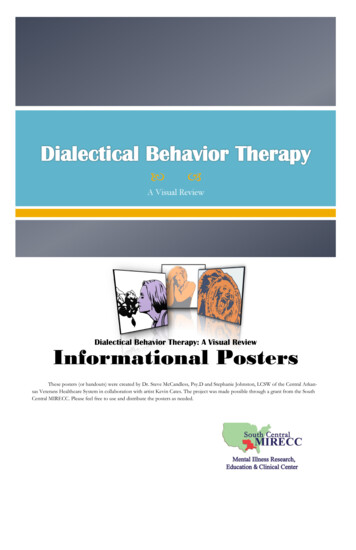
Transcription
Dialectical Behavior Therapy: A Visual ReviewInformational PostersThese posters (or handouts) were created by Dr. Steve McCandless, Psy.D and Stephanie Johnston, LCSW of the Central Arkansas Veterans Healthcare System in collaboration with artist Kevin Cates. The project was made possible through a grant from the SouthCentral MIRECC. Please feel free to use and distribute the posters as needed.
Borderline Personality Disorder is primarily a disorder of mood regulation. Individuals with BPD tend to have a moodthat fluctuates rapidly. They experience intense mood states lastingminutes to days often triggered by a person or event. There are 9 symptoms associated with the disorder, 5 of which are necessary for a diagnosis. Individuals are described as having a very reactive mood. They also may express anger frequently, which is thought to sometimes be away of covering up more painful emotions such as shame and fear.They tend to have a very unstable sense of identity. They may be unware of their likes and dislikes or they may describe themselves as a social chameleon. Their reactive mood states make it difficult to maintainrelationships and they may be particularly sensitive to signs of rejectionand abandonment. Intense feelings may lead to impulsive behaviors toalleviate their negative mood states. Perceived abandonment by othersmight also result in drastic behaviors. Often intense shame and guilt maylead to suicidal behaviors. Physical self-harm behaviors also often occur. These behaviors can be an attempt to distract from painful emotions; as a way of “snapping-out-of-it” when they feel out of touch withreality or dissociating; or as a means of feeling something when they feelemotionally numb. Borderline Personality Disorder is a constellation of biological and learned traits which are (sometimes unhealthy) means tocope with emotional dysregulation.
A biologically sensitive baby,paired with an invalidatingenvironment,can result in an individual withBorderlinePersonality Disorder.
Individuals who are born with strong emotional sensitivity can developBorderline Personality Disorderin which slight emotional triggers can cause excruciating pain.
An invalidating environment is one in which communication of private experiences is met by erratic, inappropriate, and extreme responses. Emotions that are expressed can be punished or trivialized. It tells theindividual that they are wrong for feeling the way they do, or that theirinterpretations are inaccurate.Invalidation causes problems to go unrecognized and unsolved. Thechild is told to control her emotions without being taught how to do so.Life’s problems are oversimplified. These factors combine to cause thechild to distrust and misunderstand their own emotional responses.Extreme emotional reactions are often needed for the child to be attended to. This creates a pattern of intense emotional expression inadulthood that is often misinterpreted as manipulation inBorderline Personality Disorder.
Sometimes an orchid child is born todandelion parents. The parents are unprepared to meet the child’s complexneeds, this can lead to an invalidatingenvironment and result inBPD.
Dr. Marsha Linehan’s unique approach combines both person-centered (acceptance) strategies with behavioral (change) strategies and incorporates Zen principles such as mindfulness anddialectics. Dialectics refers to the underlying assumption in DBT that opposite ideas can be combined to come up with a more balanced and indeed a more accurate view of reality. One ofthe main dialectics in DBT is that an individualboth needs to fully accept themselves as they arewhile at the same time understanding that theymust change in order to develop a life worth living.
DBT individual therapy isfocused on enhancingclient motivation andhelping clients to applythe skills they’ve learnedto specific challengesand events.The therapist consultation team is intended to be therapy for the therapists and to support DBT providers intheir work. The consultation team isdesigned to help therapists stay motivated and competent so they canprovide the best treatment possible.Teams typically meet weekly andare composed of individual therapists and group leaders who shareresponsibility for each client's care.DBT skills training group is focused on enhancing clients' capabilities by teachingthem behavioral skills. The group is run likea class where the group leader teachesthe skills and assigns homework for clientsto practice using the skills in their everyday lives.Phone coaching is focusedon providing clients with inthe-moment assistancefrom their individual therapists so they learn to useskills to effectively cope withdifficult situations they encounter.
Emotional Vulnerabilitydescribes extreme uncontainedemotions while punishment and selfblame is found in SelfInvalidation.Never endingUnrelenting CrisesThe tendency to solve problemsin an indirect manner isexplained inActive Passivitywhereas a denial that anyassistance is needed at all isApparent Competence.are perpetuated by avoidingnegativeemotions and the buildup ofunprocessed traumacharacterized byInhibited Grief.
At its core, BPD is a dysregulation of the emotional system. Thisaccounts for the intensity of emotional expression and the extreme sensitivity to emotional feelings, in particular negative emotional states. This emotion dysregulation then sets up dysregulation in other areas. Interpersonal Dysregulation includes chaoticsocial relationships and fears of abandonment. Behavioral dysregulation includes impulsivity and self-harm behaviors that are oftenseen as ways to regulate emotional states. Self-dysregulation includes problems with identity and feelings of emptiness; and finallycognitive dysregulation includes dissociation or paranoia.These dysfunctions and dysregulations can be modified by increasing the skillsets of individuals with Borderline Personality Disorder.
How to maintainawareness in thepresent momentwithout judgment.How to tolerate pain indifficult situations, withoutmaking the situationsworse, until emotionsdecrease.How to ask for what youwant and say no whilegetting what you wantand need, maintainingyour self-respect, andkeeping important relationships with others,How to decrease theintensity of emotionsthat you want tochange.
Mindfulness skills help individuals acknowledgethe present moment without judgment.Mindfulness provides a working base from whichany other skill can be applied. It helps other skillsbe more effective by giving an individual spaceto better understand problems and time to figure out how to solve them.
Wise Mind is found at the intersection of one’sEmotional Mind (animalistic, raw, hot) and one’sRational Mind (robotic, logical, cold). Either extreme is unhealthy, but both aspects are needed.Emotion mind allows us to be artistic, empathicparents, or supportive spouses. Rational mindhelps us pay our bills or solve problems. A combination of both in the middle ground is ideal. At thisintersection one uses their logic in congruencewith their emotions to maintain balance in a stateof Wise Mind.
Distress tolerance skills help individuals cope withextremely painful dysregulation without makingsituations worse. Once they have survived thecrest of their emotional waves and they havebecome more regulated, they can employ other skills to solve problems.
T in the TIPP skill stands for Temperature. Holding ice in yourhand can create powerful sensations without damagingyour body. Relief can also be felt by putting your face in abowl of ice water. (upon doctor approval) This techniqueactivates an automatic process in the parasympatheticnervous system that causes your blood pressure, pulse, andrespiration to decrease which in turn provides a calmingsensation.
The second TIPP skill is Intense Exercise. Sometimes referredto as a runner’s high, individuals experience a relaxed andsubjectively comfortable state after 20 minutes of intenseexercise that raises respiration and pulse rate. The physiological changes in the body help to focus the mind awayfrom emotional distress and can act as a distraction.
The first P in TIPP stands for Paced Breathing. Controlledbreathing with a rhythm in which the out-breath is a second ortwo longer than the in-breath can initiate a calming feeling inthe body. To practice, first breathe in through your nose, likeyou are smelling flowers. Then more slowly breathe out throughyour mouth like you are blowing out a candle. This will reducethe excess oxygen in your body and slow the fight or flight response by stopping hyperventilation.
The final P in the TIPP skill stands for Paired Muscle Relaxation. Muscles become maximally relaxed after a brief period of tension. In this skill one will tense different musclegroups starting with the feet and working the way up tothe forehead. After the initial phase of tension the samemuscle group is released and a sensation of relaxation naturally occurs. Each muscle group is done twice beforemoving on to the next muscle group. With gradual practice over time, you can remove muscle groups and attainthe same level of relaxation throughout the body by simplytensing and releasing one area, such as your hands.
Individuals may feel as if they are a rudderless ship inthe midst of an emotional storm, unable to right themselves against the waves of negative feelings that washover them. Many individual’s emotional systems areacutely sensitive due to exposure to trauma or invalidating emotional environments, genetic differences, ora combination of both. Emotion regulation skills seek toprovide individuals with tools so that they may first understand and then modify their extreme emotionalstates. Though they will always be emotionally sensitive,these tools allows individuals to no longer feel powerless against their emotional reactions. In addition Emotion Regulation skills help reduce vulnerability to unpleasant emotions while increasing the occurrence ofmore pleasant emotional states.
Justified for:Violationof MoralsAction Urge:HideOpposite Action:BeProud!
Justified for:DangerAction Urge:AvoidOpposite Action:Approach
Justified for:ImprovesLifeAction Urge:RepeatOpposite Action:Avoid
Justified for:LossAction Urge:WithdrawOpposite Action:Engage
Justified for:GoalBlockedAction Urge:AttackOpposite Action:Step Back &Be Kind
When individuals with Borderline Personality Disorder have been wrestling with intense emotions andinvalidation all of their lives, they have hardly hadtime to learn effective people skills. Their invalidating environments likely did not teach them how torelate well with others and their intense emotionshave likely gotten in the way of healthy relationships. The Interpersonal Effectiveness module in DBTskills training teaches very concrete methods of interaction so that individuals are more likely to havesuccess in their social worlds.
When the goal is to keep a relationship, clientsare taught to use GIVE. Using the Give skill teaches individuals to walk lightly and not push othersaway by being too aggressive and dominantwhen important relationships are at stake.
If one’s goal is to obtain an objective, the skill ofDear Man is used. It helps individuals to be respectfully assertive in obtaining their wants and needs.
The FAST skill outlines how to interact with others in away that will help individuals maintain their prideand integrity. It helps clients identify and validatetheir own feelings, needs, and wants.
corporates Zen principles such as mindfulness and dialectics. Dialectics refers to the underlying as-sumption in DBT that opposite ideas can be com-bined to come up with a more balanced and in-deed a more accurate view of reality. One of the main dialectics in DBT is that an ind










